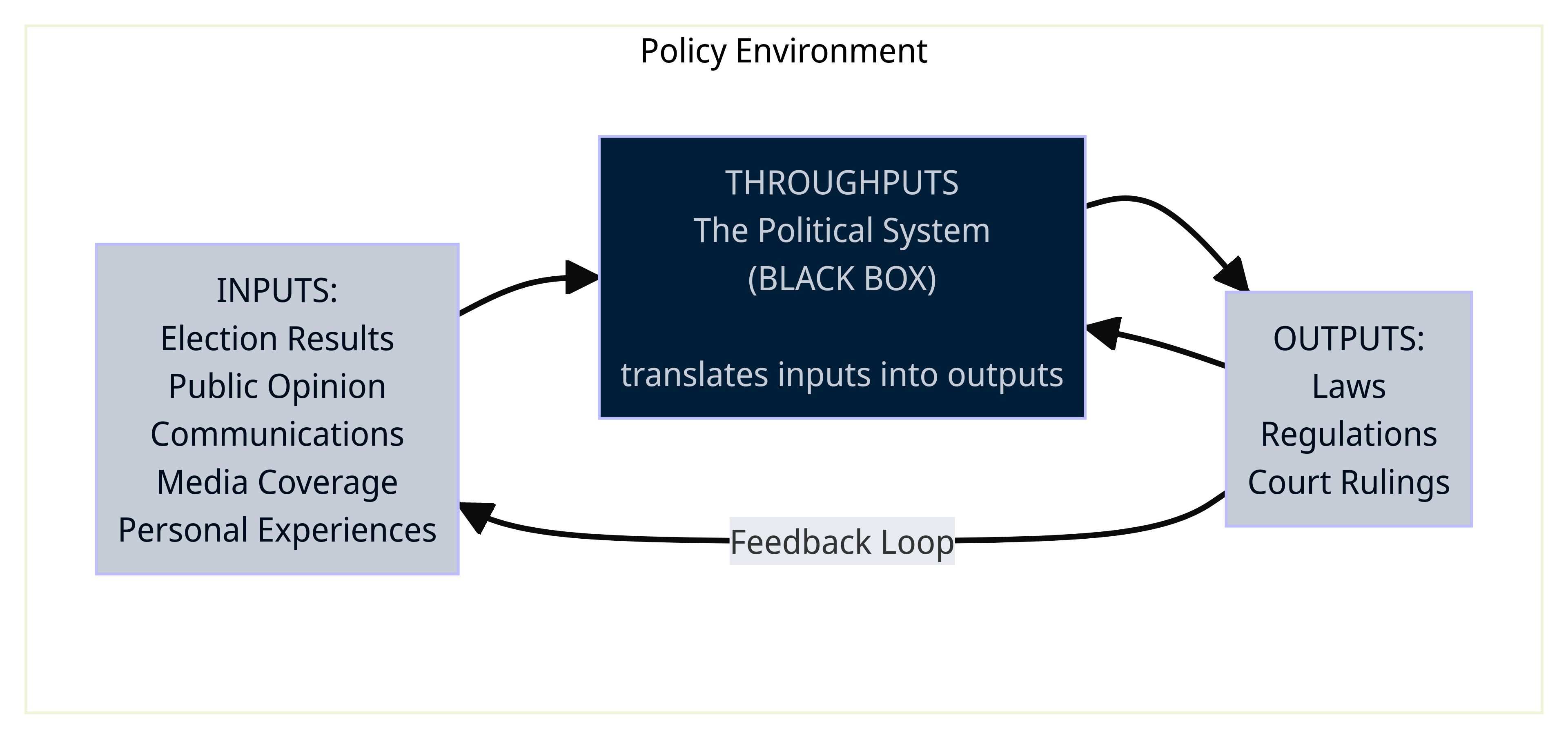Policy Process Elements
Lecture 2
Week 2
POSC 315: Introduction to Public Policy
Overview
- Policy Process Models
- The Public Policy Environment
The Stages Model

The Stages Model
- Issue Emergence: A problem is identified and brought to the attention of government officials and the public.
- Agenda Setting: The problem is placed on the government agenda for consideration.
- Alternative Selection: The government considers various policy options to address the problem.
- Policy Implementation: The government implements the policy.
- Policy Evaluation: The government evaluates the policy to determine its effectiveness.
- Policy Maintenance, Succession, or Termination: The government decides to maintain, modify, or terminate the policy.
- Issue Emergence: What new issues emerge as the policy is maintained, modified, or terminated?
Stages Model Strengths
- Intuitive: The stages model is easy to understand and explain.
- Descriptive: The stages model describes the policy process in a way that is consistent with how people think about the policy process.
- Flexible: The stages model can be adapted to different policy areas and levels of government.
Stages Model Weaknesses
- Linear: The stages model assumes that the policy process is linear and sequential.
- Oversimplified: The stages model oversimplifies the policy process by ignoring the complexity of the policy process.
- Separate: The stages model separates the policy process into distinct stages, but in reality, the stages overlap and interact with each other.
Systems Thinking
- A way of thinking about natural or social phenomena as a system with various inputs that are processed and intermingle to create a discernible set of outputs.
- A way of thinking about the world that emphasizes the relationships among the parts of a system and how the parts interact with each other and the system as a whole.
The Systems Model
- Public policy is viewed as the response of the political system to forces brought to bear on it from the outside environment.
- A policy environment surrounds the political system.
- Forces enter the political system from the environment either as demands or as support
The Systems Model

The Systems Model
- Policy Environment: The political, economic, and social context in which the policy is developed and implemented.
- Inputs: The demands and expectations of the public, interest groups, and government officials.
- Throughputs: The policy process is the interaction between the policy environment and the political system. This is the “black box” of the policy process.
The Systems Model
- Outputs: The policy outputs are the laws, regulations, and decisions that are created by the policy process.
- Feedback: The feedback is the response to the policy outputs.
- Policy Outcomes: The policy outcomes are the effects of the policy outputs and feedback.
Systems Model Strengths
- Holistic: The systems model is holistic because it considers the policy environment, the political system, and the policy process.
- Dynamic: The systems model is dynamic because it considers the interaction between the policy environment and the political system.
- Flexible: The systems model can be adapted to different policy areas and levels of government.
Systems Model Weaknesses
- Complex: The systems model is complex because it considers the policy environment, the political system, and the policy process.
- Abstract: The systems model is abstract because it does not provide a clear explanation of the policy process.
The Structural Environment
- Political System: The political system is the set of formal and informal political institutions that make and implement collective decisions.
- The basic features of American government are the separation of powers, federalism, and checks and balances.
The Social Environment
- Political Culture: The political culture is the set of shared beliefs, values, and norms that influence the political system.
- The basic features of American political culture are liberty, equality, democracy, civic duty, and individual responsibility.
The Social Environment
- Changing Demographics
- The population of the United States is becoming
- more diverse, older, more urban, more educated, more mobile.
- The government must respond to these changing needs
The Economic Environment
- Economic Conditions: The economic conditions are the state of the economy.
- The basic features of the economy are the business cycle, inflation, unemployment, and economic growth.
- Measured by GDP, size of industrial sector, unemployment rate, inflation rate, etc.
The Political Environment
- Often measured by the National Mood.
- The national mood is the public’s general attitude toward government and politics.
- Measured by the Direction of the Country question in public opinion polls.
- Measured by the Presidential Approval Rating question in public opinion polls.
The Political Environment
- Political Ads try to capture the national mood
The International Environment
- Globalization: The increasing interdependence of countries on each other.
- The basic features of globalization are the international economy, international organizations, and international law.
The Overall Policy Environment
- The overall policy environment is the combination of the structural, social, economic, political, and international environments.
- The overall policy environment is the context in which the policy process takes place.
- The overall policy environment influences the policy process.
The Overall Policy Environment
- Structural
- Social
- Economic
- Political
- International
Key Takeaways
- Policy process models help us understand how policies are made
- The stages model provides a linear framework but oversimplifies reality
- Systems thinking emphasizes relationships and feedback loops
- Policy environment shapes and constrains policy decisions
- Multiple environmental factors influence policy: structural, social, economic, political, international
That's it for Today!
Remember to read Chapter three for next time!
